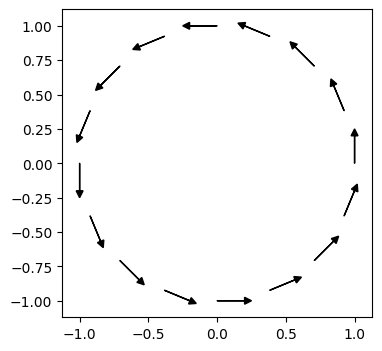7. Surface problems#
7.1. Line in plane#
7.1.1. Cell orientation for line in plane#
def set_cell_orientations(mesh):
from ufl.classes import ReferenceGrad
import firedrake as fd
V0 = fd.FunctionSpace(mesh, 'DG', 0)
X = fd.SpatialCoordinate(mesh)
flag = fd.Function(V0)
flag.interpolate(fd.dot(X, fd.as_vector((-ReferenceGrad(X)[1, 0], ReferenceGrad(X)[0, 0]))))
cell_orientations = fd.Function(V0, dtype=np.int32)
cell_orientations.dat.data[:] = (flag.dat.data_ro < 0)
mesh.topology._cell_orientations = cell_orientations
def plot_orientations_1d(mesh):
import matplotlib.pyplot as plt
plt.figure(figsize=[4, 4])
Vc = mesh.coordinates.function_space()
cell_orientations = mesh.cell_orientations()
for i, index in enumerate(Vc.cell_node_list):
coord = mesh.coordinates.dat.data_ro_with_halos[index].real
o = cell_orientations.dat.data_ro_with_halos[i]
_x = coord[:, 0]
_y = coord[:, 1]
if o > 1/2:
plt.arrow(_x[0], _y[0], (_x[1]-_x[0])/2, (_y[1]-_y[0])/2, head_width=0.05, head_length=0.05, fc='k', ec='k')
else:
plt.arrow(_x[1], _y[1], (_x[0]-_x[1])/2, (_y[0]-_y[1])/2, head_width=0.05, head_length=0.05, fc='k', ec='k')
bbox = plt.axis('equal')
from firedrake import *
import matplotlib.pyplot as plt
# mesh = Mesh("gmsh/circle_1d.msh", dim=2)
# set_cell_orientations(mesh)
mesh = CircleManifoldMesh(16)
x = SpatialCoordinate(mesh)
# mesh.init_cell_orientations(x)
set_cell_orientations(mesh)
V = VectorFunctionSpace(mesh, 'CG', degree=1)
n_h = Function(V, name='n_h')
n_h.project(as_vector([-x[1], x[0]]))
plt.figure(figsize=[4, 4])
for coord, vector in zip(mesh.coordinates.dat.data_ro.real, n_h.dat.data_ro.real):
plt.arrow(coord[0], coord[1], 0.2*vector[0], 0.2*vector[1], head_width=0.05, head_length=0.05, fc='k', ec='k')
bbox = plt.axis('equal')

def test_cell_orientation_curve():
m = CircleManifoldMesh(3)
x = SpatialCoordinate(m)
# m.init_cell_orientations(x)
set_cell_orientations(m)
U = VectorFunctionSpace(m, 'CG', degree=1)
V = VectorFunctionSpace(m, 'CG', degree=2)
f = project(CellNormal(m), U)
g = interpolate(f, V)
h = project(f, V)
assert abs(g.dat.data - h.dat.data).max() < 1e-2
print(g.dat.data - h.dat.data)
test_cell_orientation_curve()
---------------------------------------------------------------------------
AttributeError Traceback (most recent call last)
Cell In[4], line 1
----> 1 test_cell_orientation_curve()
Cell In[3], line 14, in test_cell_orientation_curve()
11 g = interpolate(f, V)
12 h = project(f, V)
---> 14 assert abs(g.dat.data - h.dat.data).max() < 1e-2
16 print(g.dat.data - h.dat.data)
AttributeError: 'Interpolate' object has no attribute 'dat'